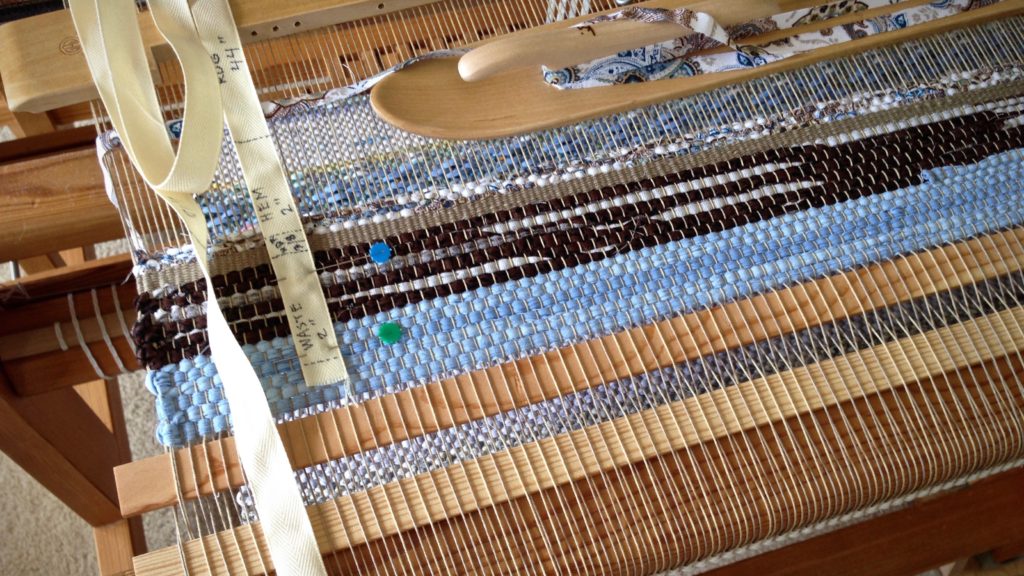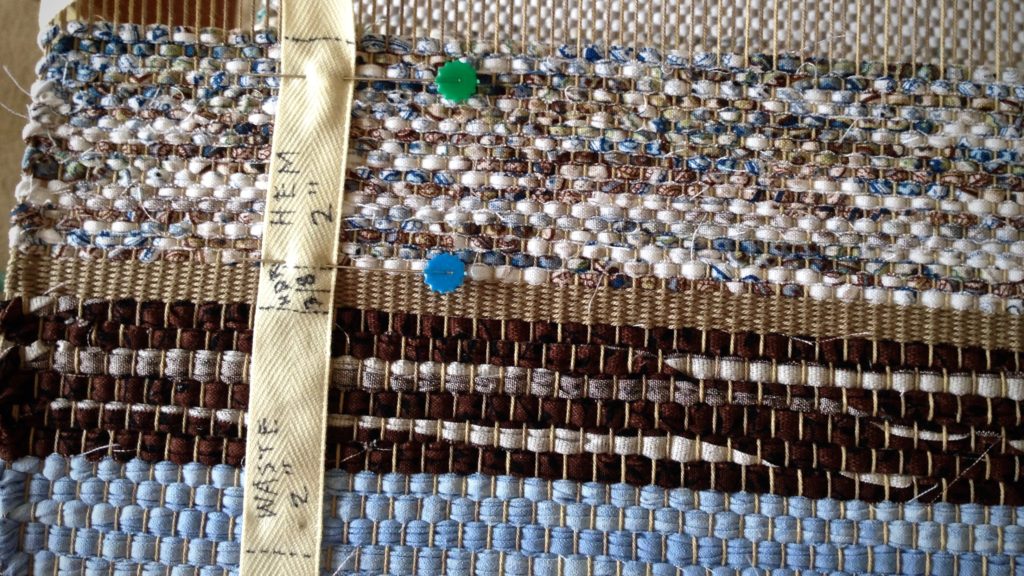It is not enough to be pretty; a good rag rug must also be sturdy. Four crucial steps give a rag rug the solid foundation it needs to get off to a great start, and to be ready for the strong beat required to make a rug that lasts.
How to Begin a Rag Rug
1 Space
Assuming there is a sample at the beginning of the warp, leave space after the sample. Leave about 4″ (10 cm) of empty warp. Then, using two warping slats, place one slat in each plain weave shed. The slats act as a spacer, and as a firm backstop for beating in the waste rags. (Leave about 8″ / 20 cm of space between each rug, from header to header.)

2 Waste rags
- a place to attach the temple
- prevent the header from unraveling when the rug is cut from the loom
Weave with scrap fabric strips, 1 – 2″ (2.5 – 5 cm) wide, for 2″ (5 cm). Attach the temple as soon as possible.
3 Header
- secures the rug weft
- gives the rug a firm edge
Use warp yarn to weave a 3/8″ (1 cm) weft-faced header. Arrange the weft in small arcs across the width of the shed. Treadle the next shed and beat in the weft.

4 Hem
- thinner rag weave, to be turned under and stitched
Cut fabric into narrow strips, 1/4″ (.5 cm) wide. Weave hem to desired length, with enough to fold under itself for finishing.
–Repeat the four steps in reverse order at the end of the rug.–

It takes courage to live by faith. Courage is the backbone against which life circumstances can push. Faith is knowing God has a higher purpose for the circumstances we find ourselves in. A rag rug with this firm starting point will not only look good, but be ready for a purpose. And so will we.
May you live courageously.
With faith,
Karen

This is a very timely post for me. My rotary cutter arrives on Tuesday and I am planning my very first rag rug. I finally have a Toika Liisa up and running so can undertake to weave something that requires heavy beating. Do you add any weights to your beater to get more sturdy rugs? Thanks so much for taking the time to explain, photograph and film. Your posts are a great read and so much more than just showing your achievement. Much appreciated! Looking forward to seeing your rug finished (and mine started)!
Hi Gerda,
I’m excited for you and your new adventure with rag rugs! I do not add weights to my beater. I can get a very strong beat with my overslung beater, because of the natural momentum in the swinging beater.
My practice is: 1. place the weft 2. beat in that open shed 3. change sheds 4. beat twice
After a while, you get a pretty good rhythm with that sequence. Though, with rag rugs it’s never “fast,” but that’s okay with me. 🙂
Very happy weaving!
Karen
Thanks so much for the post. May I ask what end per inch are you using?
Hi Susan,
The sett for this project is 8 ends per inch. I am using an 8 dent reed, with 1 end per heddle and 1 end per dent. (Except for selvedges, which are 2 ends per heddle/ 2 ends per dent/ 2 times each side.)
Karen
Thank you for sharing your techniques for weaving rag rugs and increasing my knowledge and excitement for weaving rugs. I had not thought of using narrower rags for the hem – I’ve always used coordinating yarn. Your rag technique will be used on my next rug. I am looking forward to seeing your finished project along with any tips you have for finishing your hems. Several people I weave with use glue and/or another adhesive to secure the warp ends in addition to the knots they tie before the hem is sewn down. I’m curious to learn of your techniques. Blessings!
Hi Ruth,
When you take the rug from the loom, the weaving is quite vulnerable, so I understand why some people would use glue to secure the ends. The scrap weft will begin to fall out almost immediately, so you do have to be careful. I try to do the finishing as soon as possible, and remove the scrap weft only a little at a time. You may be interested in two posts, which include videos, that explain my finishing techniques.
Tools Day: Rag Rug Finishing Video and Rickrack Rag Rug Hemming Video.
Happy Weaving,
Karen
Your videos are great. Thank you for sharing your techniques and for taking the time to respond to my comment.
You are so welcome!
This post is so timely.
I don’t seem to get sturdy enough weaving. I do not know if my weft is too thin or I am not beating hard enough. I weave on a Macomber which is a heavy loom.
I’ve been using t-shirts for weft and now have some old sheets to dye and cut. How wide are your strips?
Hi Tobie,
I’m glad this post came at a good time for you!
I cut my strips 3/4″ wide unless the fabric is very lightweight, in which case I cut them a little bit wider. I use only pre-washed cotton fabric. I’ve never used t-shirts or knit fabric for rugs, so I can’t tell you anything about that.
Several factors contribute to a solid, sturdy rug. Here are a few that come to mind:
–Tight warp – I don’t know how much you can tighten the warp on your Macomber, but I keep the warp very tight on my Glimakra.
–Find the sett that works for your weft and your loom. My usual sett is 8 epi. If the weft is not packing in tight, you might try 6 epi.
–Strong beat. I beat once with an open shed, then change sheds and beat twice. Some people add weight to the beater. I haven’t needed added weight with my overslung beater.
–Make sure your selvedges are tight. Loose selvedges will weaken the entire rug. I twist the weft twice and pull it tight around the outer selvedge.
–Use a temple. This helps with the beat and with getting tight selvedges.
Hope that helps,
Karen
This is wonderful information! Thank you! I just got an older Kessenich loom, which is pretty heavy and solid, and I’d like to try a rag rug soon. Are you using plain weave for the rug? When you twist the weft twice, do you turn the ski shuttle around itself, too? Also, do you iron the fabric strips in half? Or do you iron both long edges to the center? If you iron both to the center, do you fold it in half so they are on the inside? Thank you so much! Kathy
Hi Kathy, Great questions!
Many of my rag rugs are patterned weaves, like rosepath, which includes plain weave for the hem and between the pattern picks.
When I twist the weft, I do not turn the ski shuttle around. By holding the other end of the weft taut I can easily straighten the fabric strip in the shed.
I do not iron or fold the fabric strips at all. I cut them 3/4″ and lay them in the shed as is.
Happy rag rug weaving!
Thanks so much, Karen! This is so helpful!
Kathy
Your information has been very helpful! What treadling and draft do you use? I’d planned to just use 1,2,3,4 on the treadles and the same when changing sheds. Thanks, Kathy
Hi Kathy, There are many options for weaving rag rugs. Plain weave or straight twill are two options that will make a great rag rug.
All the best,
Karen
Thank you!